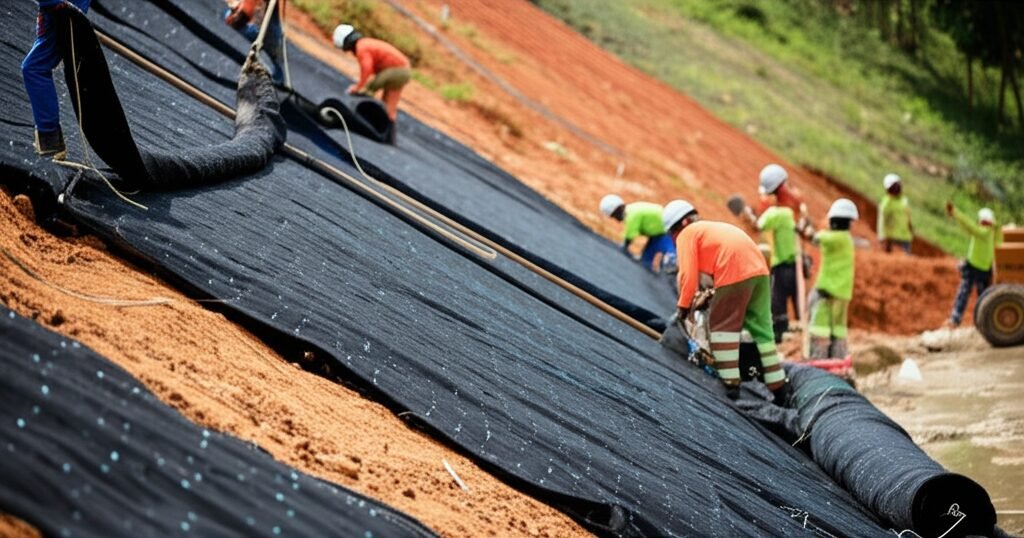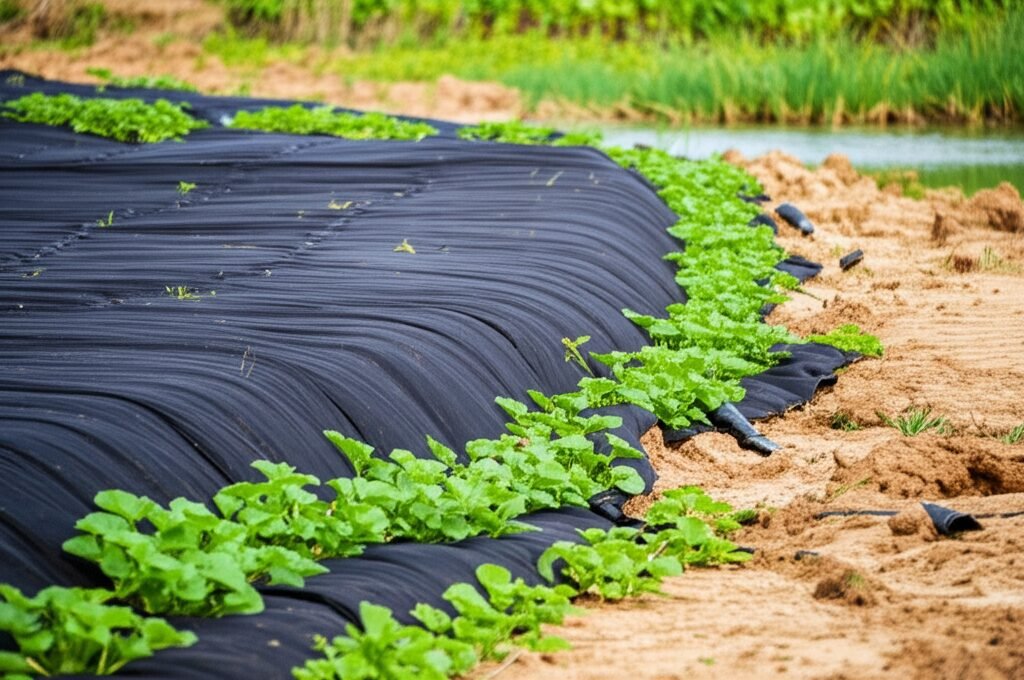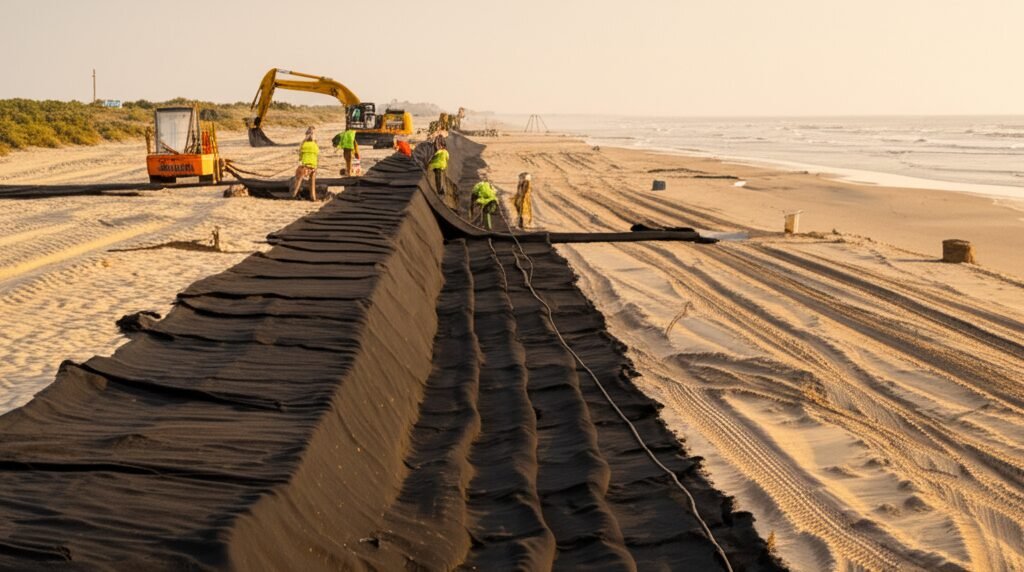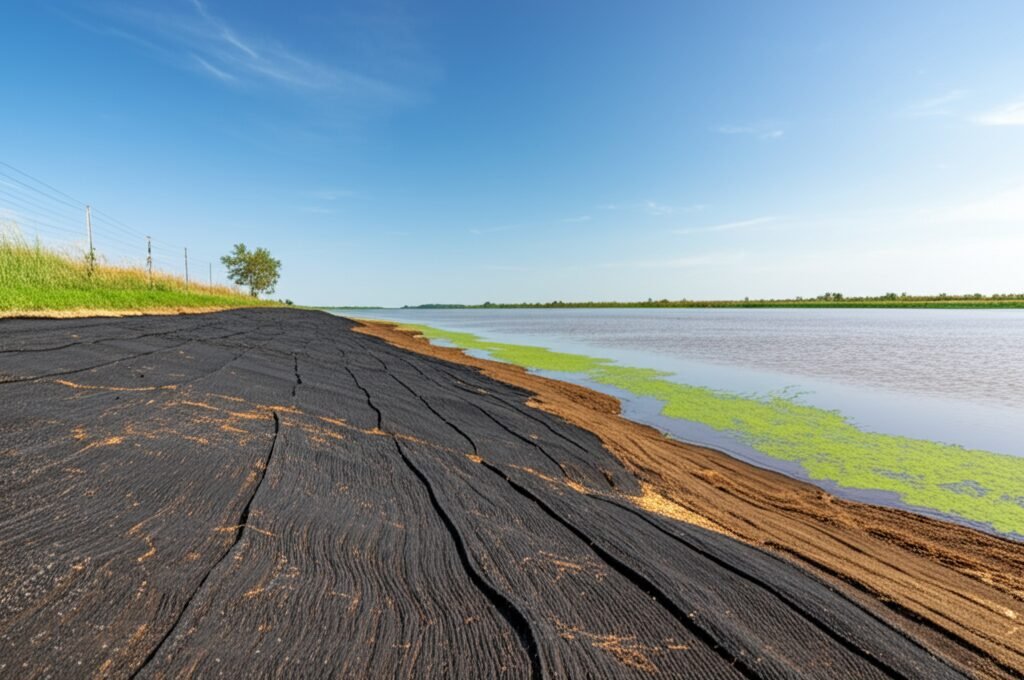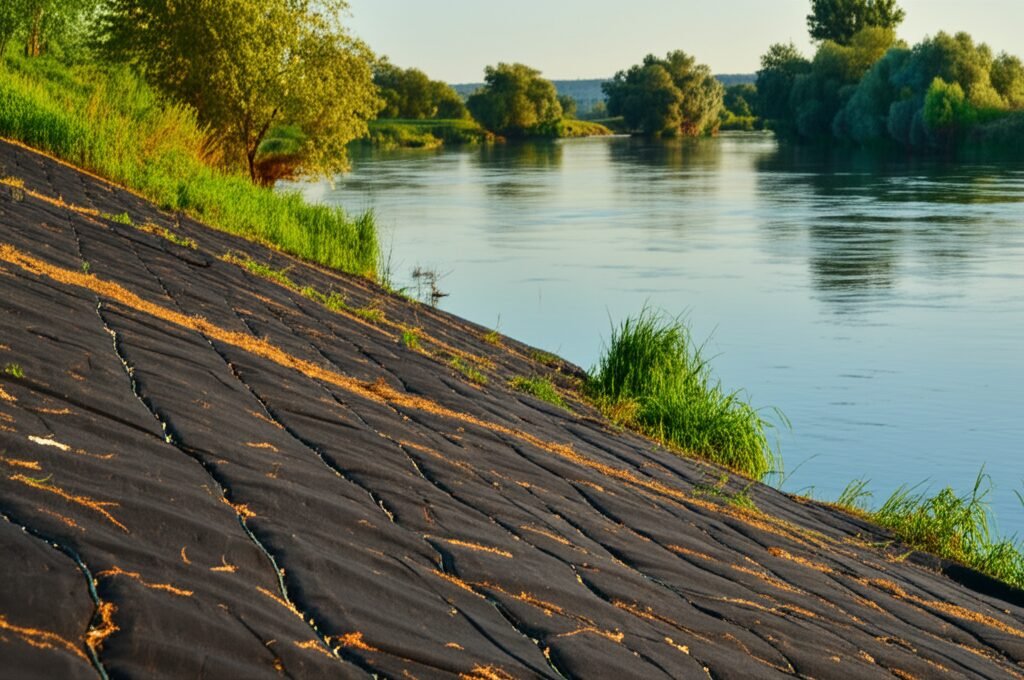Sustainable Geotextile Products: Durability and Environmental Benefits
Key Takeaways
- Less Impactful Installation: Need less heavy machinery and site disturbance compared to rock riprap or concrete.
- Reduced Material Hauling: Lighter than traditional materials, cutting down fuel use and emissions. Often filled with local sand or grout.
- Habitat Potential: Vegetation systems allow plants to grow, creating ecologically valuable areas.
- Water Quality: Act as filters, preventing excessive soil erosion into rivers and lakes.
- Longevity: Made from durable, inert materials, they last a long time, reducing the need for frequent replacements.
- Flexibility: Conform to natural ground contours, minimizing need for major earthworks.
Introduction: What are Geotextile Mattresses and Why Sustainability Matters?
Alright, let’s talk about these geotextile mattresses. You probably seen ’em on riverbanks or coastlines, maybe didn’t know exactly what they were. Essentially, they’re big fabric containers, usually made from tough synthetics, that get filled with stuff like sand, concrete, or grout. Their main job is to stop erosion, hold soil in place, and protect infrastructure like pipelines or bridge foundations. People are using them more ’cause they’re realising they can Transform Terrains with Durable Geotextile Mattresses in ways that are a bit kinder to the planet than just dumping tonnes of rock everywhere. It ain’t just about stopping dirt washing away anymore; it’s about how you do it. We gotta think about the whole picture, the environmental compatibility, and how sustainable these solutions are in the long run. The Geotextile Mattress Uses, Construction, Benefits & Installation Guide gives a good overview, but we’re gonna dive deeper into the green aspects here. It’s a shift in thinking in engineering, really. We used to just focus on “does it work?”, now it’s “does it work and is it a responsible choice?”. And often, with these mattresses, the answer’s yes.
Less Digging, Less Hauling: Material and Installation Benefits
One of the biggest pluses for the environment when you use geotextile mattresses is how much less disruption they cause compared to the old ways. Think about putting down riprap – big, heavy rocks. You gotta quarry that rock somewhere, which tears up a landscape. Then you need massive trucks, loads of ’em, burning diesel fuel to haul tons and tons of rock to the site. Then heavy excavators and cranes maneuver it into place. It’s a big, energy-intensive operation. Same goes for poured concrete revetments. You need cement production (which is notoriously energy-hungry), aggregate, transport, formwork, pouring… quite the production.
Now compare that to a geotextile mattress. The mattress itself, the fabric? It arrives on site rolled up or folded. It’s relatively lightweight. Takes up way less space on a truck than the equivalent coverage in rock. Big saving on transport fuel right there. What about the fill? Often, you can use locally sourced sand or a flowable grout mix. Sometimes, depending on the design and what’s available, you can even use material dredged nearby or readily available granular fill. This cuts down massively on hauling distances and the associated carbon footprint. Less truck traffic also means less impact on local roads, less noise, less dust. I remember a job protecting a stream bank; the alternative was trucking in hundreds of tonnes of armor stone down narrow rural roads. The client opted for mattresses filled with a sand-cement grout mixed on-site using local sand. The difference in site traffic and disturbance was huge, just way less intrusive. It makes a difference, specially in sensitive areas. These installation advantages are a key part of the story you see highlighted in guides like the Advantages and Applications of Geotextile Mattresses in Erosion Control. The polymers used, like polypropylene or polyester, are also inert which means they don’t leach harmful stuff into the soil or water once they’re installed. That stability is crucial for long-term environmental safety.
Working with Nature: Reduced Site Disturbance
Following on from the installation benefits, another key thing is how these mattresses work with the landscape, rather than just paving over it. Because they’re flexible before and during filling, they can be laid down to follow the existing contours of the ground pretty closely. Think about a winding stream bank or an uneven coastal slope. Trying to fit rigid concrete panels or angular rock requires a lot of grading – basically, you flatten or reshape the land to suit the protection material. This means heavy equipment churning up the site, removing existing vegetation (even if it’s just grasses), and compacting the soil. That’s a major disturbance to the local ecosystem, destroys habitat, and can increase erosion risk in adjacent areas during construction.
Geotextile mattresses, though? You often need minimal site prep. Maybe just some light grading to smooth out major bumps or ensure good contact, but you’re not fundamentally altering the landform in the same way. This means less soil disturbed, less habitat destroyed. On some Proven Geotextile Mattress Projects for Water Infrastructure, we’ve seen successful installations placed directly over existing low-growing vegetation, which eventually grows through certain types of mattresses. Preserving that existing ground structure and soil profile is a massive environmental plus. It helps maintain local drainage patterns, reduces the shock to the ecosystem, and allows the site to recover much faster after the work is done. I walked a site years ago where they’d used mattresses on one section of a channel and traditional riprap on another section constructed at the same time. A year later, the mattress section looked like it had always been there, just with this underlying structure, while the riprap section was still, well, just a pile of rocks. That visual difference really tells the story of reduced long-term site impact. It ain’t just about looks, it’s about function and ecological integration.
Going Green: How Vegetation Geotextile Mattresses Boost Biodiversity
Now, this is where things get really interesting from an ecological standpoint. Standard geotextile mattresses provide stable erosion control, which is already an environmental benefit by preventing sediment pollution. But some types take it a step further. We’re talking about Vegetation Geotextile Mattress Systems. These are designed specifically to allow and encourage plant growth right through the mattress structure. How do they work? Well, the fabric might have larger openings, or the system might incorporate topsoil layers or pockets within the mattress design. Once installed and filled (often with a granular material like sand or fine gravel mixed with soil), they can be seeded or planted with suitable native species.
What happens then is pretty cool. The plants establish their roots, growing down through the mattress fill and into the underlying soil. This does a couple of things:
- Enhanced Stability: The root systems effectively bind the mattress, the fill material, and the native soil together, creating an incredibly stable, integrated system. It adds natural reinforcement.
- Habitat Creation: This is the big one for biodiversity. Instead of a bare rock slope or a concrete channel, you get a living, breathing plant community. This provides food and shelter for insects, birds, small mammals, and amphibians. It turns an engineered structure into a functioning part of the local ecosystem.
- Improved Aesthetics: Let’s be honest, a vegetated slope just looks way better and more natural than grey rock or concrete. It blends the engineering seamlessly into the surrounding environment.
- Water Quality Benefits: Vegetation helps filter runoff, trap sediments, and can even absorb some pollutants.
I worked on a project restoring a degraded urban stream channel. Using vegetation mattresses allowed us to stabilize the banks effectively while replanting with native wetland species. Within just a couple of growing seasons, it went from being an eroding ditch to a thriving riparian corridor. You saw dragonflies, frogs, birds nesting – a complete transformation. Compared to the alternative of lining it with concrete, the biodiversity outcome was just leagues better. It creates a softer, greener edge that interacts positively with the environment.
Keeping Water Clean: The Filtration Factor
Another often overlooked environmental benefit of geotextile mattresses, especially those used near or in water, is their filtration capability. The geotextile fabric itself is designed to be permeable – it allows water to pass through, but retains soil particles. This is crucial for protecting water quality. When you have bare soil on a slope or riverbank exposed to rain or flowing water, fine particles get washed away easily. This is erosion, and it leads to sediment pollution in rivers, lakes, and coastal waters. Sediment makes the water cloudy (increased turbidity), which harms aquatic life. It smothers fish spawning grounds, clogs the gills of fish and invertebrates, and blocks sunlight needed by underwater plants. Excessive sediment is a major pollutant in many waterways.
Geotextile mattresses, particularly Advanced Filtration Geotextile Mattress Systems, act like a protective layer. Water seeping out from the bank (groundwater) or flowing over the surface can pass through the fabric, relieving hydrostatic pressure, but the soil particles are held back behind the fabric. This prevents that fine sediment from getting mobilized and entering the water column. Think of it like a large-scale coffee filter for the landscape edge. Systems filled with sand or grout provide a solid barrier, while the fabric ensures the interface between the fill and the native soil remains stable without washing out. This function is super important when providing Specialized Geotextile Protection for Critical Infrastructure adjacent to sensitive water bodies. Compared to, say, poorly installed riprap where fines can wash out from behind the rocks, or potentially cracked concrete allowing erosion underneath, a properly installed geotextile mattress provides more consistent filtration performance right at the soil-water interface. We did some turbidity monitoring downstream of a mattress installation on a construction site channel diversion once – the water running off that protected slope was significantly clearer than uncontrolled sections nearby. It really makes a visible difference in keeping sediment where it belongs: on the land, not in the water.
Durable Defence: Longevity and Less Intervention
Sustainability ain’t just about the materials used or the initial installation; it’s also about how long something lasts and how much fuss it takes to keep it working. Geotextile mattresses score pretty well here too. They’re typically made from synthetic polymers like polypropylene or polyester. These materials are chosen ’cause they are tough and resistant to the things that degrade materials in the environment:
- UV Radiation: While prolonged exposure can weaken them, the fill material (sand/grout/soil) protects the bulk of the fabric. Often, exposed parts use UV-stabilized threads.
- Chemicals: They’re largely inert and don’t react with typical soil and water chemistry. No rusting, no rotting.
- Biological Attack: They aren’t food for microbes or insects. They just don’t biodegrade in the normal sense (which is good for longevity, though presents end-of-life challenges we’ll touch on later).
- Abrasion: The fabric is designed to withstand abrasion from water flow, sediment, even ice in some cases.
What this means is that a well-designed and properly installed geotextile mattress system can have a very long service life – decades, potentially. This durability is a key sustainability feature. Why? Because it reduces the need for replacement or major maintenance. Every time you have to go back in and repair or replace erosion protection, you’re causing more disturbance. You’re bringing in equipment again, potentially disrupting established vegetation, and using more resources. A solution that lasts longer minimizes this cycle of intervention. Think about the long-term environmental footprint. A system needing major work every 10-15 years versus one that might last 30, 40, or 50 years+ represents a significant saving in lifetime environmental impact. Expert Geotextile Mattress Solutions for Erosion Control focus on ensuring that longevity through proper design and material selection, something championed by industry leaders like Li Gang. It’s like buying a quality tool that lasts a lifetime versus cheap ones you keep replacing – the initial investment in quality pays off environmentally down the track. Fewer interventions mean less disturbance, less resource consumption over the project’s life.
Sustainable Material Use and Future Directions
Let’s talk materials for a sec. Polypropylene (PP) and Polyester (PET) are the mainstays for geotextile mattresses. From an environmental compatibility view, they are pretty good once installed. They’re chemically stable, meaning they don’t break down and leach nasty stuff into the ground or water. They’re basically plastics, but chosen for their strength and inertness in civil engineering contexts. Now, the production of these polymers does rely on fossil fuels, and that has an environmental footprint, no doubt. That’s true for most construction materials, though. The key is whether the lifetime performance and benefits outweigh the initial impact. As we’ve seen, the reduced transport, installation disturbance, potential for vegetation, and longevity often mean mattresses come out favorable compared to hauling massive amounts of rock or concrete.
What about recycling? That’s the tricky bit. While PP and PET are technically recyclable, recycling large, dirty, potentially grout-filled mattresses pulled out of a riverbank after 50 years is… challenging. It’s not like recycling plastic bottles. Research is ongoing into better end-of-life options for geosynthetics, but currently, landfill is often the reality. However, some manufacturers are exploring incorporating recycled content into new geotextiles, which helps close the loop somewhat. There’s also development in bio-based polymers, though their use in long-term structures like mattresses, where durability is paramount, is still limited. The industry is definitely aware of the push towards more sustainable materials, much like you see in other sectors focusing on initiatives like those from the National Glass Association or exploring trends discussed in articles about 2025 Glass Industry Trends. Innovations like Raised-Pattern Geotextile Mattress Systems which might optimize material use or performance also play a role. The future likely involves a mix: improving the sustainability of current polymers (e.g., recycled content, lower-energy production), exploring viable bio-alternatives for certain applications, and designing systems for easier decommissioning or longer life spans. It’s an ongoing process driven by both environmental regs and market demand for greener solutions.
Smart Applications: Protecting Structures with Minimal Footprint
Geotextile mattresses really shine when you need serious protection for critical infrastructure, but wanna minimize the environmental damage doing it. Take Bridge Pier Erosion Control, for example. Fast-flowing water around bridge piers or abutments can dig out the riverbed material – that’s called scour, and it’s a major cause of bridge failures. The traditional fix? Dump huge amounts of large rock (riprap) around the pier base. This works, but it involves bringing in all that rock, potentially needing cofferdams or significant instream work, and it drastically alters the riverbed habitat around the pier.
Using geotextile mattresses for scour protection offers a lower-impact alternative. You can deploy the mattress around the pier foundation and fill it, often with concrete or grout for high-flow environments. It creates a stable apron that prevents the bed material from washing away. Because the mattress conforms to the bed, you often need less fill volume than riprap to achieve the same protection level. Installation can sometimes be done with less disruption to river flow, especially for Underwater Geotextile Applications. The result is stable scour protection with a potentially smaller physical footprint and less alteration of the river’s natural hydraulics compared to a massive rock pile. This is really important for fish passage and maintaining the river’s sediment transport balance. Providing these kinds of Specialized Geotextile Protection for Critical Infrastructure means you’re safeguarding the structure without completely sacrificing the ecological function of the river reach. I’ve seen designs where mattresses around piers were even filled in a way that created some surface irregularity, offering a bit of habitat complexity compared to a totally smooth concrete base. It’s about finding that balance – getting the necessary engineering performance with the softest environmental touch possible.
Balancing Act: Cost-Effectiveness and Eco-Benefits
Okay, so we’ve established that geotextile mattresses have a bunch of environmental advantages. But projects gotta be built, and budgets matter. So, how do they stack up economically, and does that link back to sustainability? Often, quite well. While the mattress fabric itself might seem like a specialized cost, you gotta look at the whole project lifecycle cost.
First off, installation. As we talked about, less heavy equipment, potentially less site prep, and crucially, reduced material transport costs (especially if you can use local fill) can lead to significant savings on the installation phase compared to riprap or concrete. That’s a direct cost saving. I’ve seen projects where using systems like specific Raised-Pattern Geotextile Mattress Systems was projected to cut overall costs by a good percentage compared to traditional methods, purely based on material volumes and handling efficiencies. Faster installation also means less labour time and potentially shorter periods of construction disruption, which can have knock-on economic benefits.
Then there’s the long term. Their durability means lower maintenance costs over the lifespan of the project. Fewer repairs, less frequent need for replacement – that saves money down the line. Now, link this back to sustainability. Often, the things that save money here are also the things that reduce environmental impact.
- Less fuel for transport = lower cost AND lower emissions.
- Less heavy equipment = lower rental/operation cost AND less site disturbance.
- Longer lifespan = lower lifetime cost AND less resource use/disturbance from repeated interventions.
- Potential for vegetation = possible reduction in long-term mowing/management costs (compared to grassed earth slopes) AND biodiversity benefits.
It’s not always a perfect overlap, but there’s a strong correlation. Sometimes, environmental regulations might require softer, lower-impact solutions, making mattresses the most feasible option regardless of direct cost comparison if hard armouring faces major permitting hurdles. On many projects I have consulted on, especially those involving Slope Stabilization & Riverbank Erosion Control, the ability to achieve robust protection while minimizing environmental impact made geotextile mattresses the preferred engineering solution, offering a good balance between performance, cost, and environmental stewardship.
Frequently Asked Questions (FAQs)
Q1: Are geotextile mattresses truly environmentally friendly given they’re made of plastic?
A: It’s a balance. While made from polymers (plastics derived from fossil fuels), their environmental benefits often outweigh this. They reduce the need for quarrying rock or using large amounts of concrete, cut down transport emissions due to lighter weight, minimize site disturbance during installation, can support vegetation for habitat, and last a long time, reducing replacement impacts. Compared to traditional “hard” methods, they generally have a lower overall environmental footprint for many erosion control applications.
Q2: Can plants really grow through geotextile mattresses?
A: Yes, specially designed vegetation geotextile mattresses allow this. They have openings or incorporate soil layers to support plant life. The roots grow through the mattress fill, creating a combined natural and engineered system that boosts stability and biodiversity.
Q3: How do geotextile mattresses help water quality?
A: They act as a filter. The fabric lets water pass through but holds back soil particles. This prevents sediment from washing into rivers or lakes, reducing turbidity (cloudiness) and protecting aquatic habitats from being smothered. It’s a key function, especially in sensitive areas.
Q4: Are they difficult or expensive to install?
A: Installation can be specialized, particularly underwater, but often requires less heavy equipment and site preparation than installing heavy rock riprap or concrete structures. While the material itself has a cost, savings on transport, fill material (if sourced locally), and potentially faster installation can make them cost-competitive or even cheaper overall for many proven projects.
Q5: What happens to geotextile mattresses at the end of their life? Can they be recycled?
A: End-of-life management is a challenge. While the polymers are technically recyclable, removing large, potentially soil or grout-filled mattresses from the environment and cleaning them sufficiently for recycling is difficult and often not economically viable. Currently, landfilling is common. However, their long lifespan minimizes how often this issue arises, and research continues into better recycling methods and incorporating recycled content into new products.
Q6: What are they typically filled with?
A: Common fills include sand, concrete, grout (a cement-sand mixture), or sometimes locally sourced gravel or soil, depending on the specific application and mattress type (e.g., vegetation systems might use more soil). The choice depends on required weight, permeability, and whether vegetation growth is desired.


